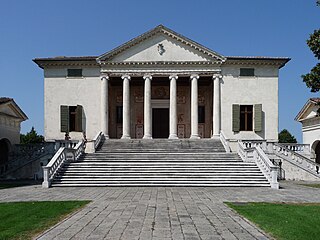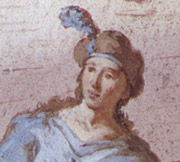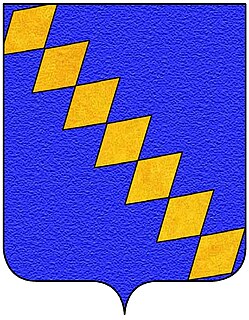
Veneto or Venetia is one of the 20 regions of Italy. Its population is about five million, ranking fourth in Italy. The region's capital is Venice while the biggest city is Verona.

Bassano del Grappa is a city and comune, in the Vicenza province, in the region of Veneto, in northern Italy. It bounds the communes of Cassola, Marostica, Solagna, Pove del Grappa, Romano d'Ezzelino, Campolongo sul Brenta, Conco, Rosà, Cartigliano and Nove. Some neighbourhoods of these communes have become in practice a part of the urban area of Bassano, so that the population of the whole conurbation totals around 70,000 people.

Villa Emo is one of the many creations conceived by Italian Renaissance architect Andrea Palladio. It is a patrician villa located in the Veneto region of northern Italy, near the village of Fanzolo di Vedelago, in the Province of Treviso. The patron of this villa was Leonardo Emo and remained in the hands of the Emo family until it was sold in 2004. Since 1996, it has been conserved as part of the World Heritage Site "City of Vicenza and the Palladian Villas of the Veneto".

Villa Badoer is a villa in Fratta Polesine in the Veneto region of northern Italy. It was designed in 1556 by Italian Renaissance architect Andrea Palladio for the Venetian noble Francesco Badoer, and built between 1557 and 1563 on the site of a medieval castle, which guarded a bridge across a navigable canal. This was the first time Palladio used his fully developed temple pediment in the facade of a villa.

The Riviera del Brenta is an area of the Metropolitan City of Venice of particular tourist-cultural interest due to the great architectural heritage of the Venetian villas built between the 15th and 18th centuries by the nobles of the Venetian Republic along the river Brenta.

Villa Pisani at Stra refers to the monumental, late-Baroque rural palace located along the Brenta Canal at Via Doge Pisani 7 near the town of Stra, on the mainland of the Veneto, northern Italy. This villa is one of the largest examples of Villa Veneta located in the Riviera del Brenta, the canal linking Venice to Padua. The patrician Pisani family of Venice commissioned a number of villas, also known as Villa Pisani across the Venetian mainland. The villa and gardens now operate as a national museum, and the site sponsors art exhibitions.
Cordignano is a town and comune with 7,020 inhabitants in the province of Treviso, Veneto, Italy.
Prata di Pordenone is a comune (municipality) in the Province of Pordenone in the Italian region Friuli-Venezia Giulia, located about 100 kilometres (62 mi) northwest of Trieste and about 8 kilometres (5 mi) southwest of Pordenone.

Villa Pojana or Poiana, is a patrician villa in Pojana Maggiore, a town of the Province of Vicenza in the Veneto region of Italy. It was designed by the Italian Renaissance architect Andrea Palladio. It is conserved as part of the UNESCO World Heritage Site "City of Vicenza and the Palladian Villas of the Veneto".

Mattia Bortoloni was an important painter of the early Italian Rococo period. He began his career as a student of Antonio Balestra of Verona and was active throughout northern Italy.

Villa Cornaro is a patrician villa in Piombino Dese, about 30 km northwest of Venice, Italy. It was designed by the Italian Renaissance architect Andrea Palladio in 1552 and is illustrated and described by him in Book Two of his 1570 masterwork, I quattro libri dell'architettura.

Villa Piovene is a Palladian villa built in Lugo di Vicenza, province of Vicenza, northern Italy. The building was commissioned in the 16th century for the aristocratic Venetian Piovene family, their architect believed to have been Andrea Palladio. It is part of the World Heritage Site "City of Vicenza and the Palladian Villas of the Veneto" since 1996.

The House of Loredan is a Venetian noble family of supposed ancient Roman origin, which has played a significant role in shaping the history of the entire Mediterranean. A political dynasty, the family has throughout the centuries produced a number of famous personalities: doges, statesmen, magnates, procurators, providures, podestàs, military commanders, naval captains, church dignitaries, writers and lawyers.

The Villa Mosconi Bertani is a Neoclassical winery and manor in the Veneto region of Italy famous for its heritage in the production of Amarone della Valpolicella wine. It is located in the municipality of Negrar di Valpolicella, Località Novare, in the province of Verona. It is the only Veronese estate since the beginning of the 18th century specifically constructed for the purpose of wine production. It consists of a residence, large cellar and orchard. Villa Mosconi Bertani is also known to have been an important centre of Romanticism, through Italian poet and writer Ippolito Pindemonte, and also the cradle of Amarone wine. The complex is listed and protected as a historical landmark by the Ministry of Cultural Heritage and Activities. The villa, park and winery are open to the public for guided tours, cultural events and private parties. The villa now is the main winery for Tenuta Santa Maria, owned by the Bertani family.

Villa Manin at Passariano is a Venetian villa located in Passariano of Codroipo, province of Udine, northern Italy.

Villa Cigolotti is an historical facility located in the Municipality of Vivaro, Province of Pordenone, in the Friuli Venezia Giulia Region on the north eastern part of Italy.

Passi de Preposulo is an old Italian noble family originally from Bergamo, Lombardy.

The Valmarana family is an aristocratic family in Vicenza, one branch of which also held Venetian patrician status. Its motto was "Plus Ultra" (Further). They were named after the village of Valmarana in the Berici Hills, where they held fiefs from the bishop of Vicenza.

Villa Spineda Gasparini Loredan is an 18th-century Palladian style villa of the noble Loredan family located in the town of Volpago del Montello in the Veneto region of northeast Italy. It is regarded as one of the most beautiful villas of the Veneto.

Villa Nani Loredan is a late 16th-century patrician villa located in Sant'Urbano, near Padua in the Veneto region of northeastern Italy. The residence gets is name from the noble Nani and Loredan families, which had historically owned it. It is managed by the Istituto Regionale Ville Venete as Villa Loredan.























